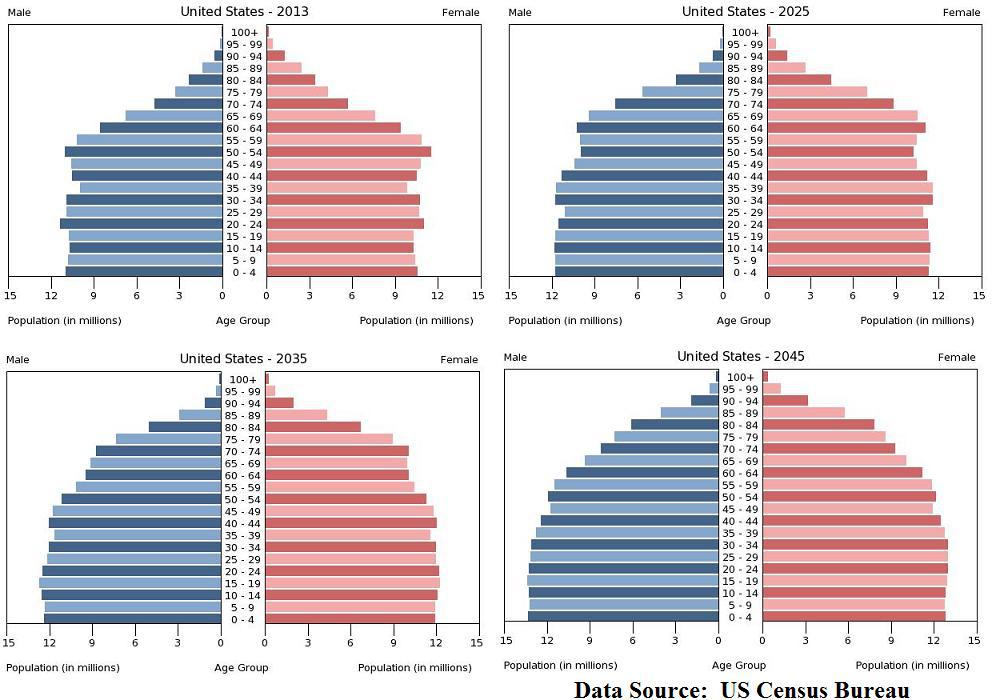If Italy’s (EWI) economic situation seems dire right now, it should be said that it has capacity to become significantly worse in the next decade. Italy faces a demographic timebomb that is likely to further exacerbate its lack of competitiveness, high corruption, and other major economic issues.
For many developed nations, entitlement programs have become a major source of economic strain. These programs are often designed on a “pay-as-you-go” basis, so that current retirees are largely funded by taxes from the current working age populace. This contrasts with a 401(k) / compulsory savings type system, where one’s contributions go directly to fund their own retirement.
The difference between the two types of systems is expounded upon by the Washington Post’s Robert Samuelson. In his article, “Would Roosevelt Recognize Today’s Social Security,” he explains how American President Franklin D. Roosevelt initially conceived Social Security more as a compulsory savings system, rather than a pay-as-you-go welfare system. While Samuelson is discussing the issue in the context of the US Social Security system, Italy and most of Europe rely on similar “pay-as-you-go” entitlement programs.
Unfortunately, this type of system creates a nightmare scenario for nations with aging populaces. Things are bad enough in the United States, where we’re worried about having only 2 working-age taxpayers to support 1 retiree in the upcoming years (as opposed to 3 or 4). Italy would love to have “our problem”, as it has one of the ugliest demographic scenarios moving forward.
Population Pyramids
To get a sense of how bad things can become, take a look at the population pyramid for the United States versus Italy. Below, you can see the projected demographic progression in the US over the next 32 years.
The US may see a lower percentage of younger workers in the total pyramid, but at least the base is consistently larger than the top of the pyramid (the retirees). In 2025, the number of Americans projected between the ages of 65 – 69 appears to be in the ballpark of 21 million. Whereas, the number of Americans between the ages of 30 – 34 is projected to be around 24 million. It’s not an ideal ratio to maintain entitlement programs like Social Security, Medicare, and Medicaid, but it’s not completely overwhelming either.
Compare that to Italy’s demographic projections for the same timeframe.
In 2025, Italy is projected to have about 4.0 million people between the ages of 65 – 69, but only 3.6 million between the ages of 30 – 34. It gets worse. By 2035, the 65-69 age range is projected to have about 4.6 million people, while the 30-34 age grouping will still have only 3.3 million. Those aren’t good numbers when your entire system depends on working-age adults paying the way for retirees.
What this means is that either younger Italians are going to have to pay significantly higher taxes to sustain this system, retirement benefits are going to have to be greatly curtailed, or a combination of the two (which is most likely).
Italy already has some of the highest taxes in the world, with tax revenues as a percentage of GDP hitting 43.5% in 2010, so further tax increases are going to be difficult to swallow. It’s difficult to imagine that new taxes wouldn’t constrain Italy’s already horrendous economic growth, and put even more pressure on the system internally.
What About Economic Growth?
Speaking of economic growth, Italy may very well have the worst record of growth in the entire developed world over the past three decades. In my view, per capita income growth is the most important measure of economic progress. It does have a few flaws, as it does not account for income disparities, nor does it account for rapid migration (particularly from lower-income nations). All the same, it’s generally the best measure available for wealth creation, so long as you account for its weaknesses.
The chart below examines thirty “Tier 1 Economies” (i.e. highly developed economies) over the past three decades, examining GDP per capita growth, real GDP growth, and population growth. As you can see Italy’s GDP per capita growth is near the bottom of the chart, in spite of having low increases in population. 
Of the five nations ranked below Italy in per capita income growth, three have significantly higher population growth rates (U.A.E., Saudi Arabia, and New Zealand) which skew their figures downward. This suggests that in reality, those three nations are doing significantly better. Even at 0.7% population growth, it can be argued that Switzerland fared much better than Italy, particularly considering the high level of per capita income it began with in 1980.
I’d argue that Italy has the absolute worst stats of the entire group and Greece is the only nation that could conceivably compete for that title. 1.2% per capita income growth over the past 31 years is particularly dismal, especially considering the extremely low population growth rate of 0.2% in that timeframe. In terms of real GDP growth, Italy ranked 29th out of 30th, with only Greece performing worse.
Things Getting Worse With Time
Italy fares very poorly on the stats in the chart above, but the chart below also showcases how their performance has gotten worse over time. The chart shows annualized GDP and GDP per capita growth rates for similar nations (European nations, US, Canada, Japan, etc). The column headings correspond with the timeframe. For instance, “21-Yr” means “21 Year Annualized Growth Rate.” 
As you can see, Italy’s GDP and GDP per capita growth rates fall over time, with the 51-year growth rate being the highest (for GDP) at 2.7%, while the 11-year growth rate is a paltry 0.4%. None of this is explained by population growth which is relatively similar for both periods at 0.6% for 11-years and 0.4% for the entire 51-year period.
We see the same trend in GDP per capita growth, with the 31-year growth rate at 1.2% and the 11-year growth rate being -0.2%. In fact, with one exception, Italy is the only “Tier 1 Economy” to have negative GDP per capita growth over the past 11 years. That exception (I mentioned earlier) is the U.A.E., where the per capita growth is skewed downward by rapid migration in from lower-income nations.
From this data, we can see that many developed nations that have done a poor job at creating wealth for their citizens over the past few decades (e.g. France, Denmark, Belgium), but Italy appears to be the only one that is actively destroying wealth.
The Euro
If all that weren’t bad enough, the Euro is an even bigger problem. The Euro has destroyed the competitiveness of many of the Southern European economies, including Spain, Portugal, and Italy. It’s estimated that Italy has lost 30% – 40% of its labor competitiveness with Germany as a result of the Euro.
Spain, Portugal, and Italy have all run large current account deficits over much of the past few years. For 2011, Italy’s current account deficit was around 3.1% of GDP, though, it has narrowed since then. Even if that sounds like good news, Italy’s GDP took a significant hit in 2012, falling 2.7% YOY in the October report, possibly a result of significant tax increases.
These tax increases were a major issue in the Italian elections, with voters increasingly angry over them. However, it’s basically a choice between higher taxes and cutting Italy’s massive welfare state. The only hope to offset this would be via growth in exports, which isn’t likely to happen unless Italy exits the eurozone.
Conclusions
While many economists and market analysts expect the Eurozone to hold up under all pressures, I’ve been a bit contrarian in expecting that at least a few (if not more) nations would eventually exit. I see Italy as a prime candidate.
Unless Germany wants to create a perma-bailout fund for Italy over the next two decades, or alternatively, creates some sort of mechanism to redistribute wealth to Italy, I find it difficult to imagine that Italy can stay solvent without absurdly high rates of unemployment and wealth destruction.
It makes vastly more sense for Italy to exit the euro, make structural reforms, and take steps to regain its competitiveness. Indeed, the rise of Beppo Grillo and the Five Star Movement in Italy may very well signal this is the direction the populace is beginning to clamor for.
Italy likely has a rocky road ahead, no matter which direction it goes. But given its structural and demographic problems, it’s only real hope to regain competitiveness and improve its dismal economic situation, is a eurozone exit.
Investment Implications
You might think given my negative outlook for Italy, I would recommend a short on Italian bonds or equities, but much to the contrary, my stance on the eurozone has consistently been to stay away entirely. In spite of the terrible headwinds that Italy will have to deal with over the next decade, everything comes down to the decisions of politicians, which are often arbitrary and haphazard.
I plan on keeping a close eye on nations like Spain, Italy, France, and Portugal over the next few years, but will probably not make any moves long or short until one nation makes a eurozone exit. Then it will be time to reassess things.
- English (UK)
- English (India)
- English (Canada)
- English (Australia)
- English (South Africa)
- English (Philippines)
- English (Nigeria)
- Deutsch
- Español (España)
- Español (México)
- Français
- Italiano
- Nederlands
- Português (Portugal)
- Polski
- Português (Brasil)
- Русский
- Türkçe
- العربية
- Ελληνικά
- Svenska
- Suomi
- עברית
- 日本語
- 한국어
- 简体中文
- 繁體中文
- Bahasa Indonesia
- Bahasa Melayu
- ไทย
- Tiếng Việt
- हिंदी
Italy Faces Ugly Future Without Reforms, Eurozone Exit
Published 03/05/2013, 07:00 AM
Updated 07/09/2023, 06:31 AM
Italy Faces Ugly Future Without Reforms, Eurozone Exit
Latest comments
Loading next article…
Install Our App
Risk Disclosure: Trading in financial instruments and/or cryptocurrencies involves high risks including the risk of losing some, or all, of your investment amount, and may not be suitable for all investors. Prices of cryptocurrencies are extremely volatile and may be affected by external factors such as financial, regulatory or political events. Trading on margin increases the financial risks.
Before deciding to trade in financial instrument or cryptocurrencies you should be fully informed of the risks and costs associated with trading the financial markets, carefully consider your investment objectives, level of experience, and risk appetite, and seek professional advice where needed.
Fusion Media would like to remind you that the data contained in this website is not necessarily real-time nor accurate. The data and prices on the website are not necessarily provided by any market or exchange, but may be provided by market makers, and so prices may not be accurate and may differ from the actual price at any given market, meaning prices are indicative and not appropriate for trading purposes. Fusion Media and any provider of the data contained in this website will not accept liability for any loss or damage as a result of your trading, or your reliance on the information contained within this website.
It is prohibited to use, store, reproduce, display, modify, transmit or distribute the data contained in this website without the explicit prior written permission of Fusion Media and/or the data provider. All intellectual property rights are reserved by the providers and/or the exchange providing the data contained in this website.
Fusion Media may be compensated by the advertisers that appear on the website, based on your interaction with the advertisements or advertisers.
Before deciding to trade in financial instrument or cryptocurrencies you should be fully informed of the risks and costs associated with trading the financial markets, carefully consider your investment objectives, level of experience, and risk appetite, and seek professional advice where needed.
Fusion Media would like to remind you that the data contained in this website is not necessarily real-time nor accurate. The data and prices on the website are not necessarily provided by any market or exchange, but may be provided by market makers, and so prices may not be accurate and may differ from the actual price at any given market, meaning prices are indicative and not appropriate for trading purposes. Fusion Media and any provider of the data contained in this website will not accept liability for any loss or damage as a result of your trading, or your reliance on the information contained within this website.
It is prohibited to use, store, reproduce, display, modify, transmit or distribute the data contained in this website without the explicit prior written permission of Fusion Media and/or the data provider. All intellectual property rights are reserved by the providers and/or the exchange providing the data contained in this website.
Fusion Media may be compensated by the advertisers that appear on the website, based on your interaction with the advertisements or advertisers.
© 2007-2024 - Fusion Media Limited. All Rights Reserved.
